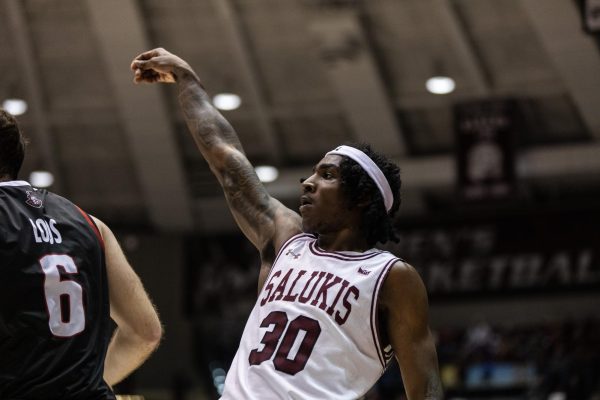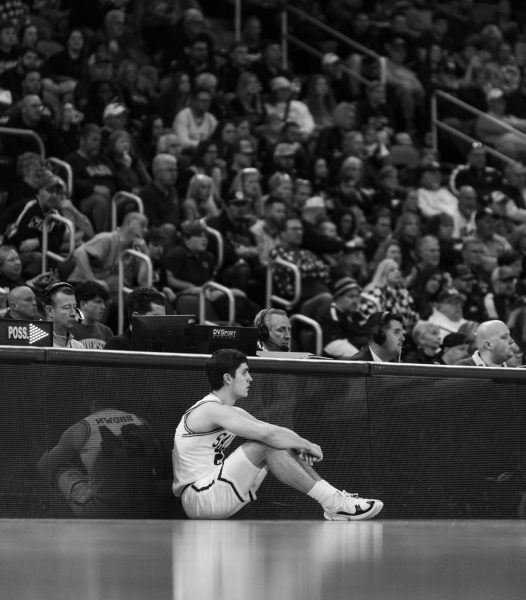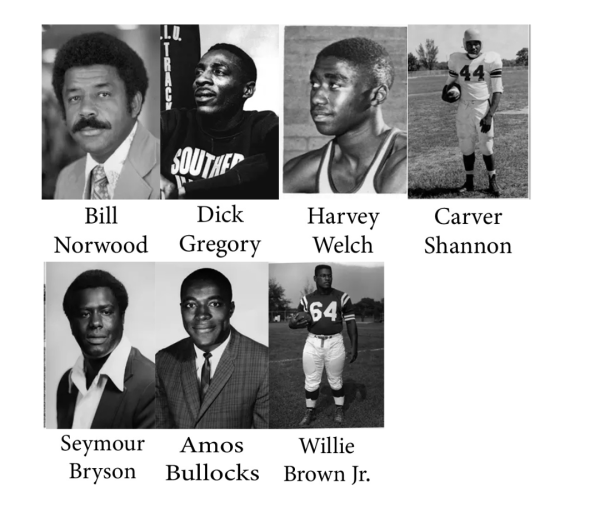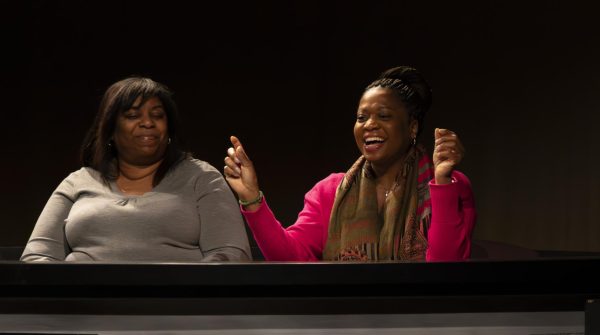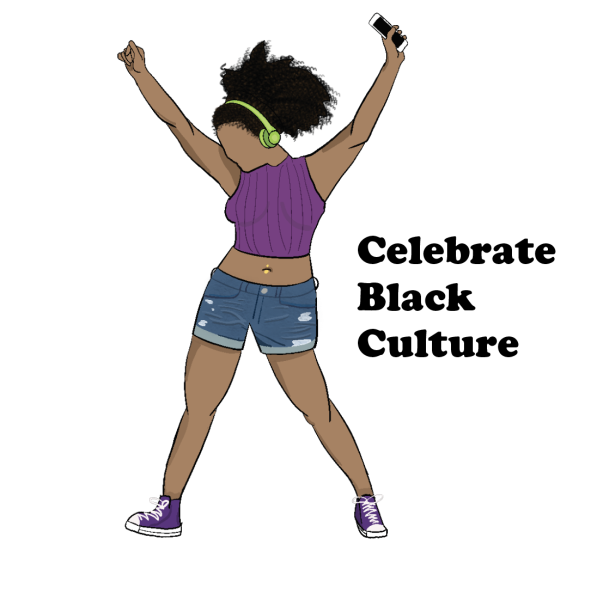Black pioneer athletes will be remembered for their legacies beyond their sport
Centralia native Harvey Welch came to Carbondale in 1951 to attend Southern Illinois University on a basketball scholarship. Though SIU was integrated, the surrounding town’s policy of excluding Black people from most aspects of public life was both familiar and isolating.
“The only place Black folks could eat was a little cafe in the old train station,” Welch said in a 1997 interview with The Daily Egyptian. “Everything else was closed or not open to Black people. That was kind of lonesome because I didn’t have anybody to relate to.”
Welch grew up in Centralia, which was also mostly segregated. It had several White grade schools and one Black grade school; all of which fed into one integrated high school. He said in a 2018 interview with The Southern Illinoisan that he learned early on that the prejudices of others would serve as a roadblock throughout his life.
Advertisement
“You will be in classes where you will not get what you earned,” Welch said, recalling what he had been told.
After high school, Welch attended Centralia Township Junior College (now Kaskaskia College), where his basketball talents impressed then-SIU head coach Lynn Holder enough to earn him a scholarship. Four years after Jackie Robinson broke baseball’s color barrier, Welch became the first Black man to earn a varsity letter in basketball at SIU.
Welch said he remembered the men’s basketball team being a welcoming environment.
“I felt like the teammates, they were all White, accepted me as what I was… they accepted my contributions and participation,” Welch said in 2018.
It was not the same story when it came to dealing with fans. One day, during warmups before a game against Southeast Missouri State, a ball got away from him and into the hands of a boy in the crowd. When he went to retrieve it, the boy threw the ball as hard as he could at his face.
Welch was an All-Conference selection in 1954, leading the Salukis in scoring that year, and remains in the top 20 in Saluki history in career rebounds per game. Welch was inducted into the Saluki Hall of Fame in 1986.
For all of his success on the basketball court, Welch said he credited his time at SIU more for the opportunities it gave him later in life.
Advertisement*
After his time in Carbondale, Welch had a distinguished career in the U.S. Air Force, where he was one of the first three Blacks to rise to the rank of colonel. He retired from the Air Force in 1975, and became the Dean of Student Life at SIU.
“This little Black boy from Centralia was in charge of the vast majority of what went on at this school,” Welch said in 2018. “That’s a hell of an achievement.”
In 2019, Welch died at the age of 86. A day later, SIU lost another trailblazer, Seymour Bryson, 81.
Bryson was not far behind Welch, joining the Saluki men’s basketball team in 1955. By the time his career was done, he had shattered the all-time scoring record with 1,529 and still remains 10th in school history. His 1,244 career rebounds remains the SIU record.
However, Bryson, a Saluki Hall of Famer Class of 1979, said he had always hoped that his career would be remembered beyond what he did on the court.
“I’ve helped bring at least $50 million in external grants to this University. I’m one of three African-Americans to progress from assistant professor to full professor here, the first African-American to serve as associate dean of a college and the second of three African-American deans on this campus,” Bryson said in 2008 when announcing his retirement.
What began as a scholarship opportunity to play basketball for the Salukis became an administrative career as the Quincy native eventually worked his way to a Ph.D, and ascended to Vice Chancellor. He also served as the university’s affirmative action officer, among several other positions.
On the weekend of their deaths, former SIU President and U.S. Congressman Glenn Poshard spoke of Bryson and Welch’s unparalleled contributions to Southern Illinois.
“When you look at the broad history of our university, these are two of the giants, reaching all the way to Dr. (Delyte) Morris and throughout our modern day history. They were two people in the middle of helping build this university,” Poshard said in a 2019 interview with The Southern Illinoisan. “They were part of that group effort that helped take SIU from a small teachers college to a large research university.”
Harold Bardo, a former teammate of Bryson’s on the 1959 men’s basketball team, recognizes the importance of sharing SIU’s history of Black athletes. He has always gone out of his way to recognize Welch and Bryson, who paved the way for his own opportunity to play basketball in Carbondale.
“Both [Bryson and Welch] lived and worked at a time of opportunity for African-Americans, and both took advantage of it,” Bardo said in a 2019 interview with The Southern Illinoisan. “Both were always trailblazers for African-Americans on this campus and in this community. So students would look to them as someone who looked like them and wanted them to succeed.”
Bardo’s path to Carbondale was somewhat unique from the other Black Salukis of his day. He came from an integrated high school in Sparta, and in 1957 was used to sharing classes with White students. There was still the typical prejudice that most Black Americans experienced, but the lives of those in Sparta weren’t that different from their White neighbors.
“Everybody was one class in that community,” Bardo said in 2003. “If your parents worked, they all worked at the same place basically.”
He remembered his time at SIU being positive, but still recognized there were problems both on campus and in the community.
“While things were good when I was here, things have never been perfect,” Bardo said in a 2018 interview with The Southern Illinoisan. “It’s an ongoing process. It hasn’t gotten there and it probably won’t get there in my lifetime.”
While he was considered a solid athlete on both the basketball and track teams, most of Bardo’s success came after his playing career was over.
A multi-time interim athletic director, most recently in 2018, Bardo was the faculty representative to the university’s athletic program for 15 years. He directed the School of Medicine’s MEDPREP program from 1984 to 1999 and from 2001 until his retirement in 2015. In 2016, Bardo was inducted into the Saluki Hall of Fame.
In a 2016 address to the Saluki football team, Bardo spoke of how athletics allows players to be leaders on their team and in their community regardless of their background. He said his entire life has revolved around the university.
Salukis weren’t just breaking barriers in basketball. While Bryson was in the midst of his all-time great career on the court, another Black man was trailblazing on the football field.
In 1956, Bill Norwood became the first Black quarterback in Saluki history. Coming from segregated Centralia, Norwood grew up without indoor plumbing. He said his ascension to a pioneer in multiple fields is not credited to any special talent, but simply working hard at his craft.
“The first thing my parents told me was you had to be twice as good to get half as far, and that kind of stuck with me,” Norwood said in a 2019 interview with ABC 7 Chicago.
The quarterback was long held as a premium position, almost exclusively given to White players. At the time Norwood joined the team, there had only been five Black quarterbacks in NFL history, three of whom debuted in the previous five years.
After a college stint that earned him All-Conference honors in 1958, Norwood, like Welch before him, joined the Air Force. He was one of the first Black Americans to fly the B-52 bomber. Six years later, he left the military to become the first Black pilot for United Airlines.
“Not everyone in the industry wanted to see African Americans as pilots,” Norwood said in a 2019 appearance for the Tuskegee Next program. “So I made sure that I was very good.”
Norwood’s career at United lasted for 31 years. During that time, he also became its first Black captain. After his retirement, his name was painted on the side of a United Airlines Boeing 727 aircraft, the plane he flew, which now hangs in the Chicago Museum of Science and Industry.
“Whenever you’re the first, first of your gender or first of your race, it puts a little bit more pressure on the professional job you perform,” Norwood said in a 2015 interview with The Daily Egyptian.
Norwood was inducted into the Saluki Hall of Fame in 1993, shortly before his retirement from United. He now lives in Mesa, Ariz. and, at age 86, is a member of the Archer-Ragsdale Chapter of the Tuskegee Airmen.
“Bill’s imprint has been left here in a number of ways,” Bardo said in a 2015 interview with The Daily Egyptian. “He was an original in terms of being a Black quarterback.”
Much of the narrative of race relations in America in the mid-twentieth century focuses on the Southern United States. Mississippi, Alabama, Georgia and the Carolinas are all the center of attention when discussing the social climate of the time. Meanwhile, in southern Illinois, things weren’t much different.
The region shares many similarities culturally with the South, including, at the time, segregated neighborhoods and schools. Many Black athletes would have to attend Historically Black Colleges and Universities in order to play college sports, and Black students would frequently face discrimination if they were allowed into the building at all.
These trailblazers came in during a transformative time in American history. While Jackie Robinson is hailed for his breaking of baseball’s color barrier, Welch had a similar impact in southern Illinois.
“In each community there was a Jackie Robinson,” Bryson said, referring to Welch, in a 1997 interview for The Daily Egyptian. “Not all were able to reach the level he reached, but what Jackie Robinson did was open doors.”
The landmark 1954 U.S. Supreme Court decision to desegregate schools came in the midst of the early Black Salukis’ college careers. The next decade would go down in the history books for the advancement of civil rights in America. As Black athletes brought change to Southern Illinois, America was undergoing its own march towards progress.
Sandwiched between Jackie Robinson breaking baseball’s color barrier in 1947 and the Civil Rights Movement of the 1960’s, was Welch, Bryson, Bardo, and Norwood. Each of them came from towns in Illinois impacted by systemic racism to varying degrees, and each of them went on to break barriers and bring change to their fields. In a pivotal point in history, these men, among several other Black student-athletes, brought Southern Illinois towards a better future.
One of those athletes was Dick Gregory, a St. Louis native who became a Saluki in 1951 on a track scholarship. He set school records in the mile and half-mile runs, and was the first Black athlete to win SIU’s Outstanding Athlete award in 1953. He was inducted into the Saluki Hall of Fame in 2000.
But for all of his athletic success, Gregory is best remembered for what came after. He went on to be a comedian, and a human rights activist. He was deeply involved in the Civil Rights Movement of the 1960’s with close relationships to figures such as Martin Luther King Jr. and Malcolm X. He protested against the Vietnam War. He was arrested multiple times and frequently went on hunger strikes.
“In all that he did, his wish was to always make people around him loveable and happy and to make America live up to her promise for all of us,” author and radio talk show host E. Faye Williams wrote in her book “Dick Gregory: Wake Up and Stay Woke: Running for Life.”
Gregory died in 2017 at the age of 84.
Julius Johnson, also a St. Louis native, was the first Black gymnast at SIU. A member of the 1956 and 1957 gymnastics teams, Johnson earned his bachelor’s at SIU in political science.
After going on to earn his law degree from Howard University in 1963, Johnson worked as a public defender, law school lecturer and assistant U.S. attorney before being appointed as administrative judge for the Department of Labor in 1976. His wife, Norma, was the first Black woman appointed U.S. District Court Chief Judge. Julius died in 2010, and Norma in 2011.
SIU also featured Black athletes who went on to become professionals in their sport. One of whom was Mississippi native Carver Shannon, who was the star running back at the time Norwood joined the team. He was an All-American in 1958, and was drafted by the Los Angeles Rams in 1959. He was on the Grey Cup-winning team in 1959 and 1961 on the Winnipeg Blue Bombers of the Canadian Football League, before joining the Rams and Chicago Bears in the NFL.
Shannon’s career was ended by a knee injury sustained during his time with the Bears. Afterwards, he spent some time as a line judge. He was inducted into the Saluki Hall of Fame in 1978, and currently lives in Los Angeles at the age of 83.
Houston Antwine, also a Mississippi native, was a two-sport phenom. He earned Associated Press Little All-America honors as a football player, and was runner-up in the heavyweight division of the National Association of Intercollegiate Athletics (NAIA) as a wrestler.
Antwine went on to be drafted by both the NFL’s Detroit Lions and the AFL’s Houston Oilers (now Tennessee Titans) in 1961. He signed with the American Football League, and was traded to the Boston Patriots (now New England Patriots). He was considered one of the league’s best pass rushers, becoming a six-time All-Star and All-AFL player.
Antwine was inducted into the Saluki Hall of Fame in 1979, and the Patriots Hall of Fame posthumously in 2015. He died in 2011 at the age of 72.
Southern Illinois University has a rich history of Black athletes. Beginning at Harvey Welch’s breaking of basketball’s color barrier, and continuing with Seymour Bryson shattering records and paving the way, Bill Norwood pioneering on the field and in the skies, Harold Bardo carrying on nearly a half-century of administrative work, and many others who have shaped not only SIU athletics history, but that of their communities and country.
Of these trailblazers, only a few are still alive: Norwood, Bardo, and Shannon. The surviving athletes have continued to spread their stories and the stories of others to anyone who will listen.
These men each took perhaps the biggest steps towards progress: the first. It is important to know and celebrate that history, and what marginalized people did to build the world that we live in today. Now, the only way left to go is forward; remembering what came before us, and celebrating what is to come.
Staff reporter Brandyn Wilcoxen can be reached at [email protected] or on Twitter at @Brandyn_2020. To stay up to date with all your southern Illinois news, follow the Daily Egyptian on Facebook and Twitter.
Advertisement






